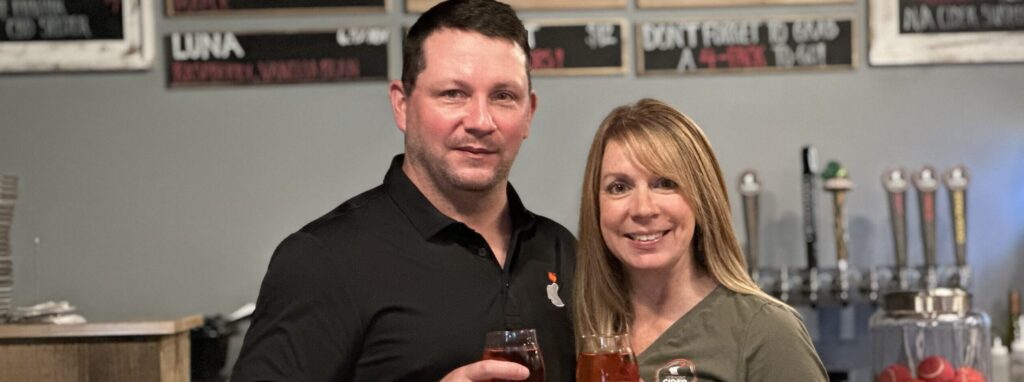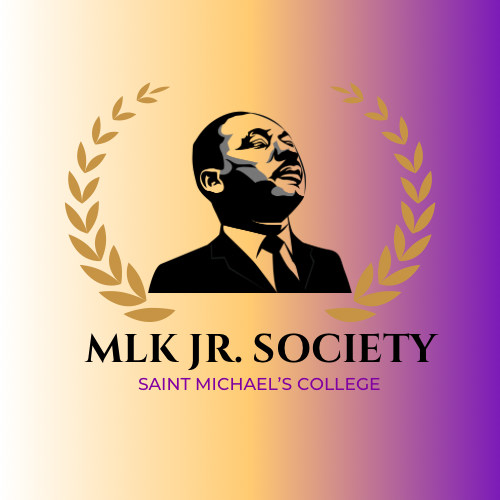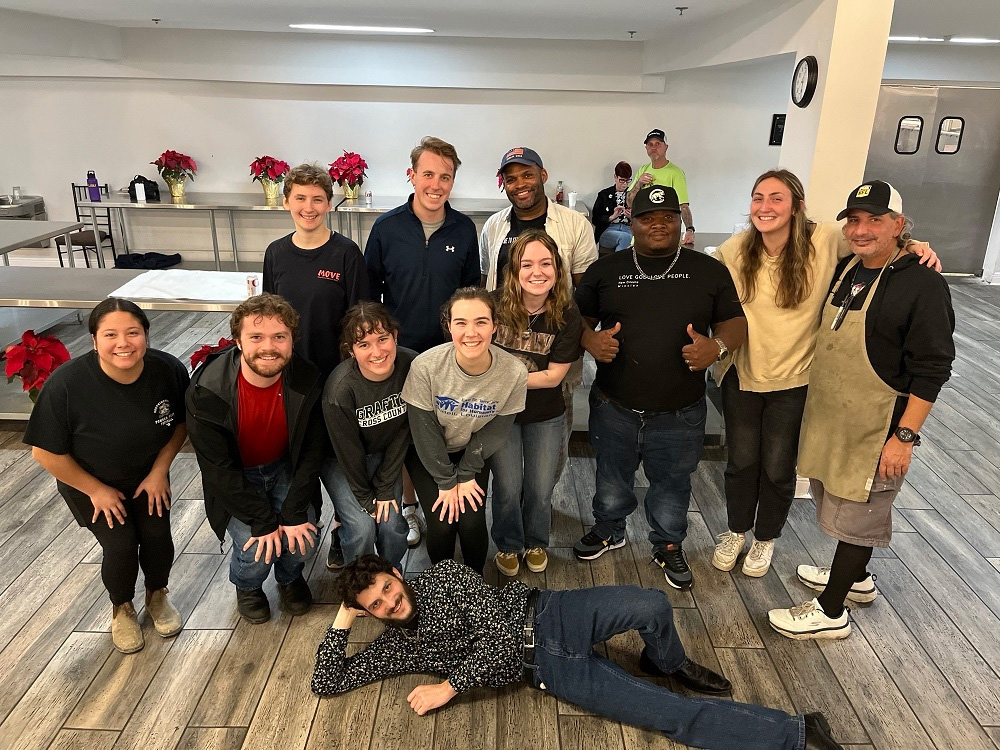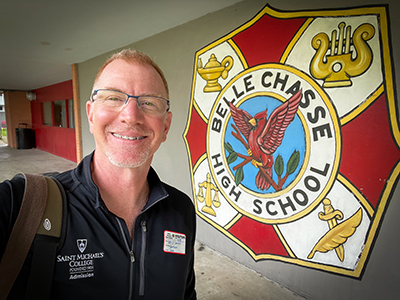Station manager Stumpf at WWPV
Station manager Stumpf an ambitious champion of WWPV
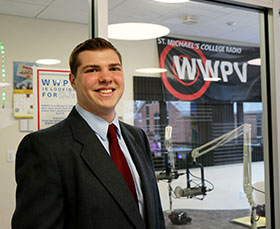
Paul Stumpf outside the studio with a sharp new sign visible in the studio window behind him. Images below show a DJ in the studio and various shots of studio, looking out into Dion, the back-space areas, the classic sound board, and others. (top two photos by Eva Wilton ’19, other photos courtesy of Paul Stumpf.)
While Saint Michael’s College’s student radio station WWPV has an FCC-prescribed broadcast signal that is relatively low-power, this year’s senior station manager Paul Stumpf is anything but.
The upbeat and tireless physics major, a four-year WWPV DJ and rugby player from Norwalk, CT, said his priorities this year have included improving WWPV’s website, programming, technology, funding and its Dion Student Center glass-enclosed studio and adjoining space –filled now with increasingly popular-again vinyl records and comfortable listening and study spaces that seem to be a hit with students who crowd in there.
Since WWPV has Student Government Association club status on campus, it has fallen on Stumpf this year to advocate before the SGA for what he regards as much-needed funding just to assure the most basic necessary upgrades. His PowerPoint presentation before the SGA recently laid out what WWPV is all about, spotlighting its achievements:
- Founded in 1974 (the long-ago predecessor was WSSE with earlier studios on North Campus and then St. Edmund’s Hall until a 2014 move to Dion), it’s a non-profit, student-operated radio station which since 2009 has played student-selected music 24-7, with a staff of more than 70 DJ’s live on air from 8 a.m. to 2 a.m. each day.
- WWPV has gained national recognition from the Princeton Review for several years among the nation’s top 10 to 20 college stations, and has been active on and off campus partnering with venues in Burlington/Winooski like Radio Bean and Monkey House while informing the community of local and visiting artists and concerts.
- Initiatives this year have included participation or sponsorship fall semester of an Open Mic/DJ mixer with Turtle Underground (the on-campus music and social club, a campus TEDx event, a College Showcase at Winoo
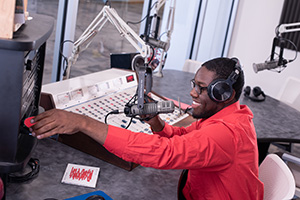 ski’s Monkey House; and, for spring semester, live interviews with artists, Open House tours of the station, and competing in the College Broadcasters National Student Production Awards, to name a few.
ski’s Monkey House; and, for spring semester, live interviews with artists, Open House tours of the station, and competing in the College Broadcasters National Student Production Awards, to name a few.
- “In-House” improvements have included a new streaming mobile app, upgraded request line, a new window sign with the call lettersmake in the campus MakerSpace, an updated website and equipment/software, a new record player table and a new setup in the “back room”
- Externally, along with the Princeton Review high rankings for college radio station (No. 16 in 2019 and No. 8 in 2018, the station has been featured in the College alumni magazine. The station reports data to prominent national studies and research initiatives in local radio, and reports to the college radio music charts NACC and RadioFX.
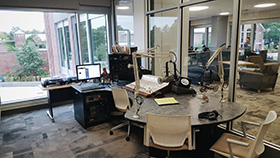
- Expenses include licensing fees and royalties and engineering/miscellaneous fees totaling $5,765 this year, and the station receive $6,000 from the SGA, leaving just a small amount for some of Stumpf’s hoped-for forward-looking projects. He notes that the station’s budget in 2009 was $15,000 and has become significantly less in subsequent years, with all clubs feeling a pinch from these economic times: $7,500 in both 2015 and 2016, and only $7,000 in 2017. He said an extra $1,000 just received for spring semester from the SGA (after seeking $2,000) would cover the most urgent needs: an audio encoder that is necessary to update computers to Windows 10, installation of the “On-Air” sign, CBI membership and equipment, everything from an 8-channel mixer, Raspberry Pi computer, various records/vinyl cleaners and related items, headphones, audio cables, stickers (very popular with students) and WWPV shirts.
Stumpf said one popular initiative he and other DJs have enjoyed immensely is having student bands from St. Mike’s or from nearby towns to play gigs in the studio, live from the station in Dion, and do interviews. Stumpf has talked about expanding to have local high school bands on as well. “My priorities have been getting foundations put down so next year the group that takes over can do more of these fun activities,” he said.
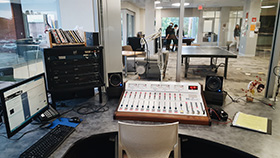 The station manager said his own WWPV show of the past four years features “lots of rock and Irish music” — an hour each typically. “My family is deeply into Irish dancing together where I grew up outside New York City, so I listened to that music a lot on a Fordham station well known for that in my younger days,” he explained.
The station manager said his own WWPV show of the past four years features “lots of rock and Irish music” — an hour each typically. “My family is deeply into Irish dancing together where I grew up outside New York City, so I listened to that music a lot on a Fordham station well known for that in my younger days,” he explained.
Stumpf hopes to stay involved in community radio at least as a sideline wherever he lives after graduation, but he sees a more likely career in some other business near his home area in Connecticut, where he would like to return. However, he notes that some former WWPV leaders have found radio careers, such Liam Elder-Connors ’14 who is at Vermont Public Radio. Elder-Connors’ father John Connors has for many years been the staff adviser to the station, and had his own blues show on the station too.
The new, improved and just-launched WWPV website has a variety of features that Stumpf shows off proudly, such as a page to view student projects, or mini-pages about student bands that let those bands share photos music “If you’re from St. Mike’s, we’ll play your music,” Stumpf said, adding that this includes alumni band, whether still in the area or now someplace else.
Membership in the College Broadcasters, Inc. (CBI) allows St. Mike’s student DJ’s to send recordings of their shows to possibly win national contest awards in various categories, and he expects some entries this year. “We have maybe 70 trained student DJ’s but that does not tell the full story since that doesn’t include all their guests – friends or roommates,” said Stumpf. “I’ll see at least four kids in the station studio at a time since they like to show up and hang with their DJ friends, maybe suggest songs — this is common. So it’s really maybe closer to 100.”
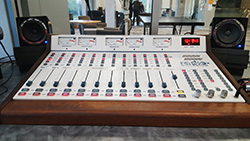 He’s currently inviting applications for the WWPV Executive Board, and typically, somebody from that seven-person board will apply to be the next year’s station manager Depending on interest and needs, the station often also will have one or two music directors or social media directors who screen music submissions or do reviews. “We’re hoping to make these students jobs,” he said.
He’s currently inviting applications for the WWPV Executive Board, and typically, somebody from that seven-person board will apply to be the next year’s station manager Depending on interest and needs, the station often also will have one or two music directors or social media directors who screen music submissions or do reviews. “We’re hoping to make these students jobs,” he said.
Stumpf says a big portion of the station’s fans now listen online in nearly 50 countries around the world. A central piece of studio equipment is an old-school sound board/mixer — an older but excellent one that engineers under contract keep running with periodic service calls. A new one would not be required until the engineers say “too much is breaking or parts can’t be replaced,” and at that time it might cost more than $10,000. But, says Stumpf, “so far, so good.”
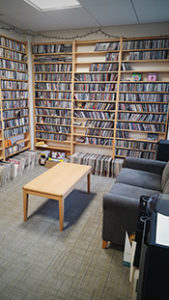 An interesting phenomenon in Stumpf’s view around the studio is the resurgent popularity of vinyl records over CDs. Many students have their own collections and prefer the tactile, larger records and artistic covers to CDs or digital online music collections. This trend has made the thousands of records brought over from the old studio more relevant than even a few years ago, and most days now, students can be found listening to them or transferring music from records to their digital devices since the station’s back room now contains the technology for that. Many classic rock albums date back to the ‘70s and ‘80s and now are in great demand, he said.
An interesting phenomenon in Stumpf’s view around the studio is the resurgent popularity of vinyl records over CDs. Many students have their own collections and prefer the tactile, larger records and artistic covers to CDs or digital online music collections. This trend has made the thousands of records brought over from the old studio more relevant than even a few years ago, and most days now, students can be found listening to them or transferring music from records to their digital devices since the station’s back room now contains the technology for that. Many classic rock albums date back to the ‘70s and ‘80s and now are in great demand, he said.
The station also now has an online page through the campus Canvas software that allows student DJs to view all the new music and news and announcements that they should say on the air, along with instruction manuals and technical information; it also has an option for them to look at playlists. A new streaming site straight from the station’s Spotify account shows playlists with all the new music for a week. One page on the site “is filled with comments from alumni who did WWPV or even WSSE as students, and love to share the story of St. Mike’s radio.”
But whether it’s the website or the station itself, Stumpf said, “It’s always a work in progress.”
